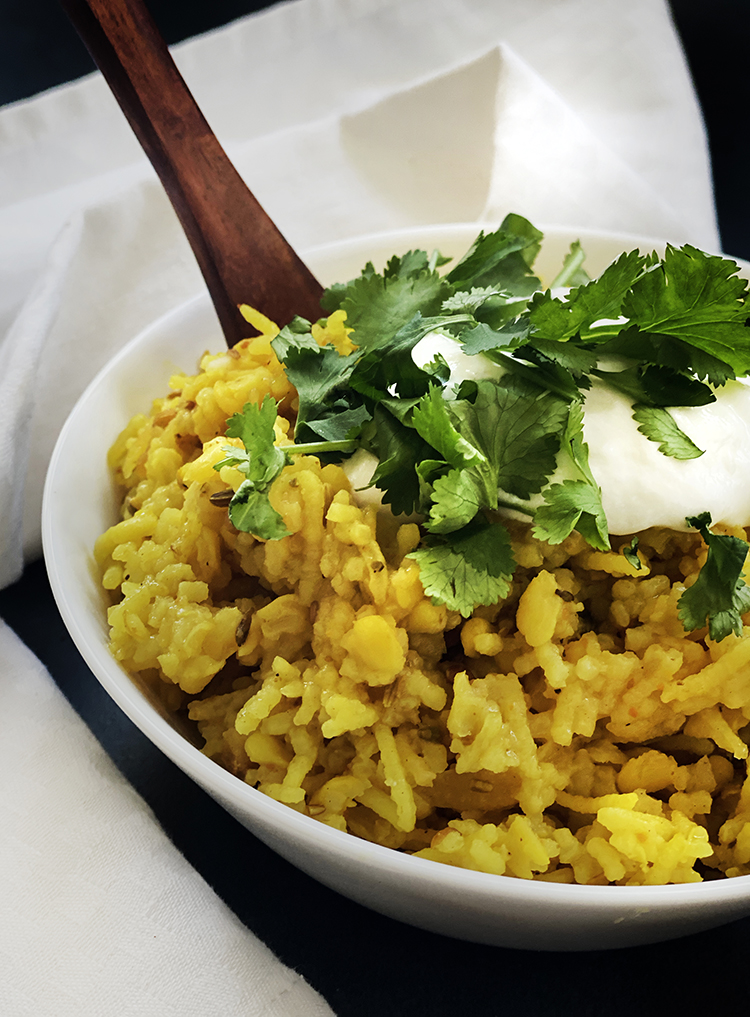Kitchari
Warming & Grounding
Qualities
Easy to Digest | Healing | Nourishing
Time & Season
Anytime
Year-Round

In Ayurveda, Kitchari (pronounced Kich-i-ree); is considered the ultimate Sattvic (pure) food. Served in every Indian household and in Ayurvedic clinics, this is a neutral, light, and soft dish that both cleanses and nourishes the body, without supporting imbalances of any kind. In fact, Kitchari is thought to remove toxins from the system, and is used as a tool to deepen spiritual practices, like meditation and Yoga. This complete one-pot meal is a mixture of rice and lentils, cooked with spices and Ghee (clarified butter) to a porridge-like consistency. Kitchari is known to provide complete protein, and is very gentle on the digestive system.
Serves 4-5
Ingredients:
8-10 cups boiling water
1 cup white basmati or red rice
1 cup split yellow mung beans, whole green mung beans or red lentils
2 tbsp ghee, olive oil or coconut oil
1 tbsp grated fresh ginger
1 tbsp cumin seeds
1 tbsp fennel seeds
1 tbsp coriander seeds
1 tbsp turmeric powder
1 tsp ground black pepper
1 tsp pink Himalayan rock salt
Garnish:
Lemon juice
Fresh cilantro (or parsley)
Ghee or olive oil
Preparation Method:
– Pre-soak the rice and lentils for at least 1 hour, then rinse them until the water runs clear.
– In a large pot, add the cumin, coriander and fennel seeds and dry-toast them until they start to release their fragrance. Add the turmeric powder, grated ginger, black pepper and the rinsed rice and lentils. Stir everything together until the grains are coated with the spices.
– Add in 8 cups of hot water, bring to a boil and cover with a lid. Turn the heat down to a low flame. Simmer for 20 minutes without stirring. Check after 20 minutes to see if it needs more water.
– When the Kitchari is well cooked and the grains become soft, add the salt and ghee (or olive / coconut oil). Stir well, cover, and leave for few more minutes. Kitchari should have a soupy, soft consistency.
– Serve it in a bowl and garnish with fresh cilantro or parsley, a squeeze of lemon juice and extra ghee or oil on top.
Notes:
– Vata Modifications:
Consistency: Thick and substantial (cook with 8-9 cups of water)
Ratio: 2:1 rice to lentils (use 1.5 cup rice, 0.5 cup lentils)
Lubrication: It should be extra oily. Add more ghee, olive oil or coconut oil
– Pitta Modifications:
Consistency: Medium thickness (cook with 9-11 cups of water)
Ratio: 1:1 rice to lentils (use 1 cup rice, 1 cup lentils)
Lubrication: It should be moist. A little ghee or extra oil is fine
– Kapha Modifications:
Consistency: Soupy and watery (cook with 11-13 cups of water)
Ratio: 1:2 rice to lentils (use 0.5 cup rice, 1.5 cup lentils)
Lubrication: It should be dry. Avoid adding extra oil or ghee
